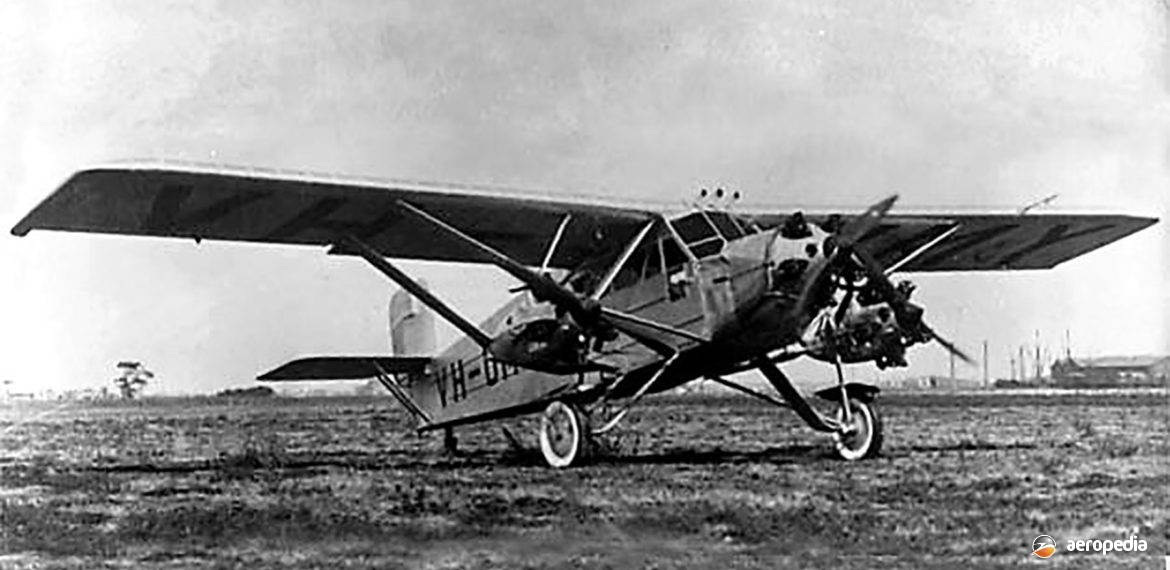Photograph:
Larkin Lasconder VH-UMY (c/n 347) at Coode Island Aerodrome, VIC in 1929 (Eddie Coates collection)
Country of origin:
Australia
Description:
Light commercial airliner
Power Plant:
Three 112 kw (150 hp) Armstrong Siddeley Mongoose five-cylinder radial air-cooled engines
Specifications:
- Wingspan: 15.24 m (50 ft)
- Length: 10.54 m (34 ft 6 in)
- Height: 3.53 m (11 ft 6 in)
- Wing area: 33.6 m² (362 sq ft)
- Max speed: 190 km/h (118 mph)
- Cruising speed: 153 km/h (95 mph)
- Landing speed: 90 km/h (56 mph)
- Rate of climb at sea level: 274 m/min (900 ft/min)
- Ceiling: 4,572 m (15,000 ft)
- Range: 644 km (400 miles)
- Empty weight: 1,610 kg (3,550 lb)
- Loaded weight: 2,654 kg (5,850 lb)
History:
The Lasconder was the second commercial aircraft designed and built by the Larkin Aircraft Supply Company Ltd (LASCo). This company was set up by Herbert Joseph Larkin, DFC, Croix de Guerre aven palme, being one of the early aviation organisations in Australia, it having previously been known as the Larkin-Sopwith Aviation Company. A subsidiary was Australian Aerial Mail Services. The Company commenced offering joy-rides from the Glenhuntly Aerodrome near Caulfield, VIC with a Sopwith Dove (G-AUJJ).
In the late 1920s well known British aeronautical engineer, William Stancliffe Shackleton, became chief designer of the company and designed the six-seat single-engine Lascoter (VH-UKT), this aircraft, powered by a 179 kw (240 hp) Siddeley Puma engine, flying for the first time on 18 May 1929. In late 1929 he commenced design of a large three-engine aircraft at the Company’s new premises at Coode Island, VIC construction commencing in October 1929. Accommodation was provided for seven and payload was 602 kg (1,327 lb). Part of the design aim was to utilise parts already designed and built for the Lascoter, the largest common component being the mainplanes. The section used in the prototype Lasconder was in fact built for the second Lascoter, which was not completed.
The prototype Lasconder (VH-UMY – c/n 347) was ready for testing on 23 March 1930 and made a demonstration flight for staff on 2 April 1930 at Coode Island, being flown for the first time on that date by Captain E W Leggatt. The Certificate of Airworthiness was issued on 3 July 1930. On 28 April 1930 at Coode Island (by then known as Melbourne Airport) it was christened by Lady Somers, wife of the Victorian Governor. The Company also built the Lark glider; and was involved in the construction of a DH.50A (VH-UMN); and the production of 32 de Havilland DH.60s for the RAAF (A7-23 to A7-54). It was also involved in the re-engining and modification of the Anec III, this aircraft then becoming known as the Larkin Lascowl. At one time the company had 110 employees.
The Lasconder was a high-wing braced monoplane of composite construction, with a wood mainplane and empennage, and steel-tube fuselage with weldless patented joints, with fabric covering, powered by three Armstrong Siddeley Mongoose radial air-cooled engines. It was extensively damaged when it ground-looped at Coode Island following the failure of a radius rod on an undercarriage leg.
It had been proposed that the aircraft would be used by the MacKay Expedition to central Australia the following month but the accident required the substitution of two examples of the company’s Lascowl design. By 1 July 1930 the Lasconder was airworthy again and subsequently made a series of successful flights in Victoria, NSW, Queensland and the Northern Territory. In later years Jimmy Larkin stated the aircraft never required a single modification during its life and at one stage flew over Canberra on two engines with Prime Minister Scullin and the Minister for Trade and Customs on board.
On 4 November 1930 the aircraft was damaged at Coffs Harbour, NSW whilst on a flight from Roma in Queensland to Melbourne, and had to be shipped to Victoria to effect repairs. It would seem due to lack of finance the Company was unable to complete repairs for sometime but by April 1933 it was again flying, a number of test flights being made from Camooweal in QLD. In 1935 LASCo ceased trading and the assets were acquired by New England Airways. Subsequently the aircraft is believed to have been abandoned at Camooweal aerodrome. It is known the substantial remains of the aircraft, including two of the engines, have survived and have been preserved but remain in private hands in storage.

